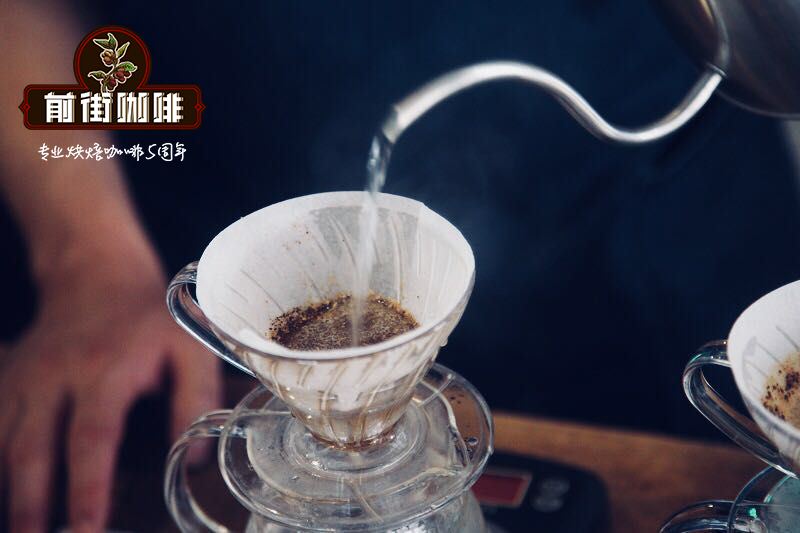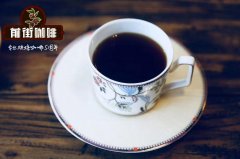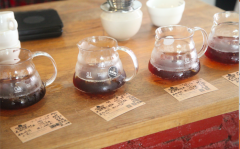Five positions for making coffee by hand

There are many ways to brew coffee, and there are N ways to brew coffee by hand. Is your hand good for coffee? What position is suitable for you to rush your hands? Today, the editor will introduce to you five common positions for hand-made coffee!
Volcanic flushing
The method of volcanic flushing comes from Japan and is more suitable for deep-roasted coffee beans. It uses the carbon dioxide in beans, and after many times of steaming, the coffee powder bulges like a volcanic eruption, so deep-baked beans are more suitable because they contain more carbon dioxide.
Flannel and V60 are mostly used in volcanic flushing, because the middle powder layer is very thick, so it is mainly filled with water in the middle about the size of an one-dollar coin. The key point of the first half of volcanic thrust is full extraction without destroying the powder layer. The second half is uniform water injection, in order to prevent excessive extraction in the middle, play a dilution role.
Advantages: coffee taste mellow, with mellow and strong body, sweet obvious.
Disadvantages: due to the volcanic impact of the first 1 stroke 3 is excessive extraction, and the latter 2 stroke 3 is insufficient extraction, resulting in uneven coffee liquid, after flushing, it is necessary to shake well, so that the two "failed" coffee liquid mixed together to form a perfect coffee. However, shaking well in the time, will make the temperature drop, if you want to directly maintain the temperature with high temperature extraction, it will lead to dry coffee.
Loose house method
The Matsuya method also comes from Japan, which was invented to extract only the delicious ingredients from the coffee.
Use a spoon to dig a big hole in the coffee powder, about 30cm from the noodle, pour water from the middle until the coffee liquid begins to drip, then draw a circle like a circle to wet the coffee powder and cover it with steaming. After 3 minutes, uniform and uninterrupted water injection began. Stop filling when the coffee liquid reaches half of the coffee pot, and then add hot water to dilute it.
Advantages: even after a period of time, the flavor of coffee will not change much.
Disadvantages: some friends say that because the extraction time is too long, the flavor will evaporate a lot. So there is no great change in the flavor of coffee. Do you think this is its disadvantage or advantage?
Stirring method
Why is the mixing method so popular? On WBC in 2012, Matt Perger became popular in Europe, America and Australia after it was used and won the championship of that year.
The stirring method needs to grind the coffee powder to very fine, then inject about 50g of water, stir evenly back and forth in the cross direction, so that the coffee powder is in full contact with the water, and then inject water after 30 seconds, and complete the water injection in 2 minutes. The deep-baked beans need to be steamed for 15 seconds and then filled with water for 1 minute and 30 seconds.
Advantages: the mixing method can amplify the advantages of the coffee beans, especially enhance the taste of the coffee beans, and will not be too thin.
Disadvantages: although its flavor is more obvious, its return is weakened a lot. And this method has high requirements for the quality of coffee beans, if you use poor coffee beans, it will only infinitely magnify its bad flavor. In addition, because the grinding degree of coffee powder required by this method is very fine, coupled with sufficient stirring, it is easy to over-extract improperly.
Drip method
Drip method, as the name implies, is to brew in the form of dripping water. Just like the hourglass, dripping bit by bit into the coffee powder, it is completely delicate and time-consuming!
First, the coffee powder is pre-soaked and moistened with a little bit of water. when the coffee powder is dripped almost 1 stroke 3, you can start to inject water, stop when the water level of the coffee powder reaches the top, and inject water again when the water level drops to half.
Advantages: drip method can make coffee beans sweet and avoid sour and bitter tastes.
Cons: it requires a very stable grip and patience. It can be said that all the sour and astringent taste of the coffee it removes is handed over to you. Some friends said that getting rid of the sour and bitter taste would also make the flavor of the coffee not so complete.
Academic Chong method
Academic brewing is the most commonly used way of brewing hand-brewed coffee, and it is also one of the first choices for most coffee lovers because of its stability.
Its method of operation is very simple, injecting water from the center, then steaming, and then slowly injecting water from the inside to the outside again after the collapse. But this method requires more demanding hand brewing pot, which requires delicate, vertical, stable and uniform water flow, so that a good cup of coffee can be brewed.
Advantages: academic cooking method is very stable, suitable for most filter cups and beginners.
Disadvantages: similarly, its advantages also contribute to its disadvantages. Many coffee lovers think that this brewing method is too stable to form their own style and characteristics.
In fact, whether a cup of coffee is good or not, there is no fixed standard, whether it is good or not, as long as you like it. Like, what does that phrase say? Radish and green vegetables have their own preferences, clothes and hats have their own preferences.
All right, posture is good, the object goes home early! Go and practice!
Author: TIMEMORE Coffee slow Life
Link: https://www.jianshu.com/p/003c04f56ff5
Source: brief book
The copyright of the brief book belongs to the author. For any form of reprint, please contact the author for authorization and indicate the source.
Important Notice :
前街咖啡 FrontStreet Coffee has moved to new addredd:
FrontStreet Coffee Address: 315,Donghua East Road,GuangZhou
Tel:020 38364473
- Prev

Description of flavor and taste characteristics of honey-treated coffee beans description of honey-treated coffee beans
Professional coffee knowledge exchange more coffee bean information please follow the coffee workshop (Wechat official account cafe_style)
- Next

[Qianjie barista's Note] which total proportion of powdered water is suitable for ice-fire flushing?
Professional coffee knowledge exchange more coffee bean information please follow the coffee workshop (Wechat official account cafe_style) yesterday a friend asked the editor about the previous [ice fire] powder ratio, at that time, the comparison between [ice fire] and [ice hand] only compared the flavor of the coffee liquid extracted between the two, without testing the flavor after the ice melted, and then sent.
Related
- What is the meaning of lactic acid fermentation with coffee bean treatment?
- How to judge the state of foam by sound?
- How does the latte pull out the unicorn pattern? Come to get for a little trick to improve the flower pull!
- Will flower pulling affect the taste of the latte?
- Do you know the history of coffee?
- The difference between honey treatment and sun washing what is raisin honey treatment?
- What kind of milk can a novice use to make coffee foam to keep the foam longer? The correct method and skills of milking tutorial sharing
- Why do washed coffee beans taste sour? Flavor characteristics of washed Coffee
- Introduction to the skill of how to practice the size and height of water injection around the circle of hand-brewed coffee
- How do beginners practice coffee flower drawing from scratch?

